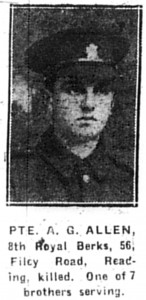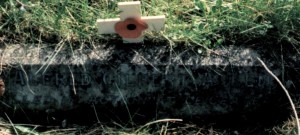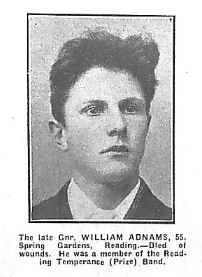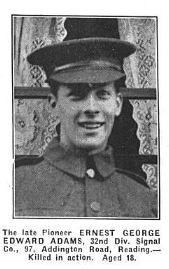Albert Gilbert Allen
Private 45498
8th Battalion Royal Berkshire Regiment
 |
 |
Albert Allen was aged 18 years when he was killed in action on 23rd October 1918. He was the youngest of seven brothers serving “Their King and Country”. The notice of his death appeared in the Chronicle on 6th December 1918. His parents lived at 56, Filey Road. Albert’s name is commemorated on the Vis-en-Artois memorial panel 7. The memorial was erected to the memory of those who fell in the advance from 8th August 1918 to the Armistice 11th November 1918.
On the 22nd October 1918 the 8th Battalion moved to Le Cateau, as part of the 18th Division which was due to attack the following day. We are told in “Their Duty Done” Colin Fox et al that “by late evening the men were in their assembly positions east of the village facing L’vÃque Wood. The ground over which the attack was to be made was rough grassland with no connected trench systems but with strong German defensive positions organised in depth around machine gun posts……………..Zero hour was 1.20am on 23rd October. The Royal Berkshires’ assembly point was a deep railway cutting east of Le Cateau from where they would advance onto the second objective. Enemy shelling here caused 15 casualties…..a temporary dressing station was blown in by a gas shell…….At 1.15am the companies moved out of the cutting…..A creeping barrage moving forward at the rate of 25 yards a minute supported the attack……..At day break the enemy began to retire and Captain M Wykes took the leading companies of the two battalions and rushed the road, capturing over 30 light and heavy machine guns. The advance continued and the second objective, a line some 1,500 yards beyond the first…..was taken by 8.30am and held throughout the day”. The total advance for the day was some 8,000 yards. Casualties for the day were reported as one officer killed, two officers wounded, other ranks – 19 killed, 1 died of wounds, 67 wounded and 3 missing. Albert Allen was one of those killed in action.

